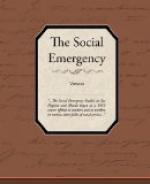At this or some other fitting time, the father or mother may give the child some further intimation of the process by which the child comes to grow in the mother’s body, and in some such way as follows: “Some one may have told you how babies come to grow in their mothers’ bodies. But most people are ignorant about these things. I think I can explain it to you a little if you will look for a moment at this flower that I have in my hand, because the coming of a baby in the mother’s body is in some ways like the coming of the seed in the body of the flower. You have probably learned at school in your nature-study work that these are—what? Yes, the petals. And these stamens, and this is the pistil. Do you notice the powder on the end of the stamen? That is called pollen. If you put that powder under magnifying glass, each grain will look like a grain of wheat. Now, do you notice that the pistil spreads out here at the base like a vase with a narrow neck and big bowl? I am going to cut the thick part open. Do you notice those tiny things like seeds? Yes, those are seeds, but they would not grow just by themselves. A grain of that pollen gets on to the end of the pistil (sometimes the wind, sometimes a bee puts it there), and immediately it begins to send a long thread from itself right down the center of the pistil, and this thread carries at the front the heart of the pollen grain, and when it reaches the tiny seed the two go together and the heart of the pollen joins with the heart of the seed and then it is a true seed and can grow,—and can grow into another plant that can have flowers that can have seeds, and so on almost forever. No one fully understands this very wonderful fact. We only know that it is a fact,—that the heart of a seed from a father flower had to join to the heart of a seed of a mother flower before a true seed that can grow into a plant is born. And we only know that something like this is true about father and mother animals, and that something like this is true of our own human father and mother.”
So much to show how the parent may “break in,” for that is often the crucial thing. After the start is made, details may be found in the books provided for just this purpose.[40] Indeed, after beginning, it is sometimes better to put the right book into the boy’s hands; or better yet to read the book with the child. Especially is the latter course preferable if the book seems at any point unwise,—and there are few books prepared for children which are not at some point or other unwise. Only, in all this process of definite instruction in which analogies from the life of plants and animals are used, the instructor must make sure that the illustrations are thought of as analogies for the anatomy and biology only, and guards must be reserved, implicitly and explicitly, against the child’s supposing that everything in plants and animals is normal for human beings. All that the child learns of reproduction of plants and animals should be related to the home and affectional life even of animals, and the analogy between animals and man should stop far short of that to which in all the animal world there is no real analogy—the life and meaning of the higher order of human family life.




